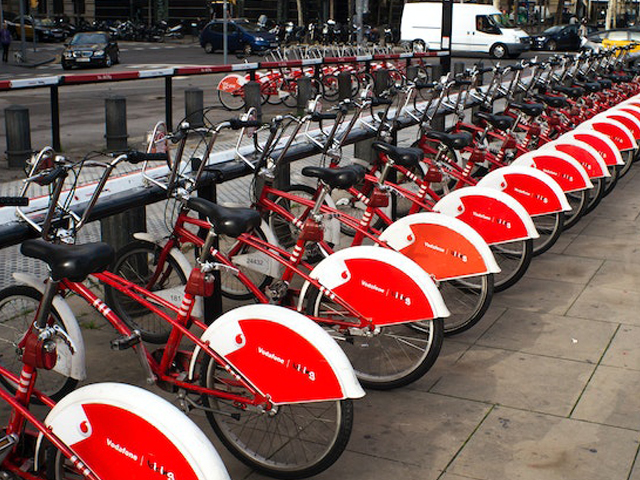
Riding a bike to school may seem daunting for both kids and parents, but doing so has countless benefits. Not only is it an eco-friendly option to reduce pollution, but it also helps promote healthy habits from an early age. To encourage more students and families to take the plunge into biking, schools across the country have adopted strategies that make biking safer and easier for everyone. We've compiled a list of 6 strategies that any school can implement to make their campus greener while encouraging positive health habits — so let's get ready to bike or bust.
1. Install Bike Racks
One of the simplest ways to encourage biking is by installing bike racks on campus. Schools can alleviate concerns about bike theft or damage by providing secure storage spaces, which may often deter students from opting to cycle. Well-placed bike racks in visible and accessible locations also serve as a constant reminder and encouragement for students to consider biking as a feasible commuting option.
The types of bike racks installed matter, too. Schools should ensure that the racks can accommodate bikes of various sizes and are designed to minimize potential damage to bicycles. Additionally, the chosen bike racks for schools should be sturdy and weather-resistant, ensuring longevity and reducing the need for frequent replacements. The sight of well-maintained bike racks subtly communicates to the students that the school cares about their biking needs.
2. Promote Biking Through Education
Educating students on the benefits of biking can be a great way to get them excited about taking part in this eco-friendly behavior. This could involve sessions focusing on the benefits of cycling, such as its positive impact on the environment and personal health. Schools could also arrange bike safety and maintenance workshops and provide resources on local cycling routes and communities. By embedding cycling into their educational curriculum, schools can nurture an appreciation for biking and its numerous advantages from an early age.
In addition to this, schools could organize biking events or competitions to further cultivate interest and enthusiasm in biking. For example, "Bike to School Week" could be an excellent initiative encouraging students to take up cycling. Another idea is to have a "Bike Rodeo" or a safety fair where students can learn about bike safety in a fun, engaging environment. These events can strengthen the cycling culture in school and help build a sense of community among students.
3. Incorporate Biking Into School Activities
Incorporating cycling into school activities can be an effective strategy to promote this green mode of transportation. Schools could include biking in physical education classes or after-school clubs, exposing students to the fun and fitness aspects of cycling. In doing so, students get the opportunity to learn about biking techniques, road safety rules, and bike maintenance, while also enjoying the thrill of cycling in a supervised setting.

Another potential strategy is to organize school trips or excursions that involve biking. For instance, schools could arrange nature explorations or historical site visits on bikes. Not only would such trips be exciting for students, but they would also help foster camaraderie among them. Moreover, these activities provide a practical context in which students can apply their knowledge about biking safety and maintenance, helping reinforce these key learnings.
4. Offer Incentives for Biking
Offering incentives can be a powerful tool to motivate more students to bike to school. Such incentives could be presented in many forms, from tangible rewards to recognition. For instance, schools could implement a points system where students earn points every time they cycle to school. These points could then be exchanged for rewards such as school supplies, extra recess time, or even vouchers for local businesses. By associating biking with positive reinforcement, students may be encouraged to adopt this green and healthy mode of transportation more consistently.
Public recognition can also serve as an effective incentive. Schools could dedicate a space on their bulletin board or newsletter to celebrate and acknowledge the efforts of students who frequently bike to school. This could include featuring 'Biker of the Month' profiles or sharing success stories of students who have embraced biking. This form of positive peer recognition can inspire other students to partake in biking, fostering a biking culture across the school community.
5. Provide Bike Storage Options
Aside from installing bike racks on campus, schools should also consider providing other bike storage options. This is especially important for students who come from long distances and may need access to their bike rack. Schools could offer sheltered areas such as lockers or garages where students can store their bicycles during the day. Such initiatives can make biking more accessible and reduce the need for students to take a car or public transportation to school.
Additionally, schools could look into providing bike rental services. This would enable students without access to a bicycle to still be able to partake in biking activities on campus. Schools could partner with local bike shops to offer reasonable rent rates and discounts for school events. By providing such services, students are encouraged to partake in biking without worrying about the hassle of ownership.
6. Advocate for Bike-Friendly Policies
To promote a campus biking culture, schools should advocate for bike-friendly policies that support cycling within their local community. This could involve participating in programs or initiatives to improve infrastructure for cyclists in the area. Schools could also work with local governments on initiatives such as bike lanes and greenways, promoting a safer environment for cycling. Through these efforts, schools can create external motivation for students to take up biking as a commuting option.
Finally, schools should consider forming partnerships with other stakeholders, such as businesses, community organizations, and transportation authorities. These collaborations could focus on various initiatives, such as organizing bike campaigns or setting up bike-share systems in the area. By forming these partnerships, schools can strengthen their efforts in promoting biking in their local community and beyond.
These are just a few strategies that schools can use to create a healthier, greener campus. By introducing students to biking and encouraging them to make it part of their everyday lives, we can help pave the way for an eco-friendly future. In short, cycling is an excellent way to improve health, reduce environmental impact, and offer numerous other benefits. Schools should embrace this green mode of transportation by implementing comprehensive strategies that support more students in cycling.











